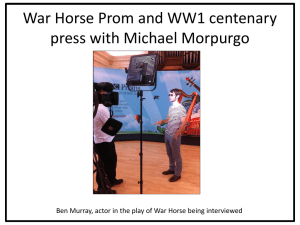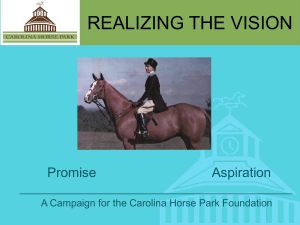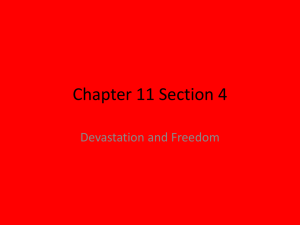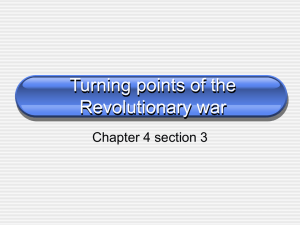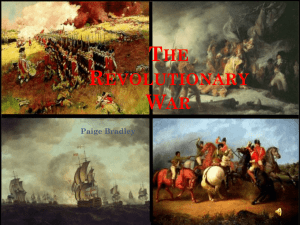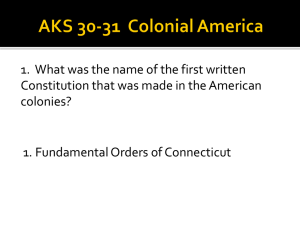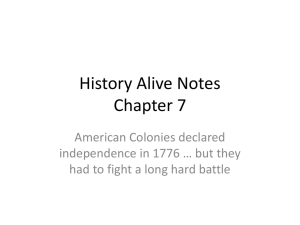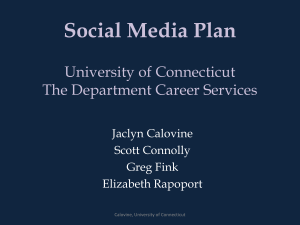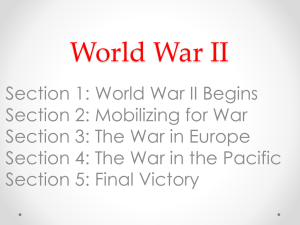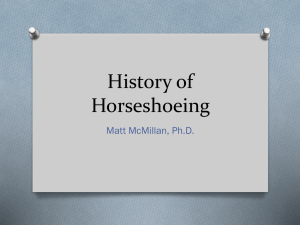Second Continental Light Dragoons Presentation
advertisement
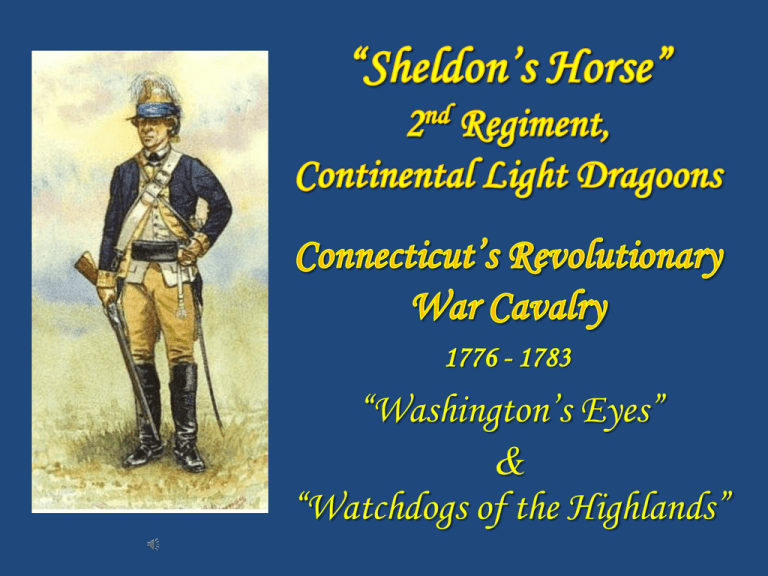
1776 - 1783 “Washington’s Eyes” & “Watchdogs of the Highlands” The first Congressional cavalry regiment in the history of the United States Army as authorized by the Continental Congress and commissioned on Dec. 12, 1776 by Gen. George Washington. 2 The nation calls, her sons respond in thunder tones 3 Flags under which “Sheldon’s” served. Connecticut State Flag Regimental Device “Betsy Ross” Flag Regimental Flag “Tarleton-Bedford” Flag 4 Things in which the nd 2 was st 1 … • First commissioned cavalry in US history. • First “Pony Express”. • First cavalry charge on American soil at the Battle of the Flocky. • First organized U.S. espionage system. • Achieved victories on foot, horseback and at sea as whaleboat raiders capturing British vessels on Long Island Sound. 5 Notable names among the men of the nd 2 Light Dragoons 6 Col. Elisha Sheldon (1741-1805) – First Congressional Cavalry commander Put his reputation and his personal liberty at risk to supply his men. Survived the war and moved his family to what became Sheldon VT. Maj. Benjamin Tallmadge (1754-1835) – Washington’s Spy Master; Friend of Nathan Hale; Litchfield Town postmaster 1792; First Treasurer of the Society of the Cincinnati; Secretary of the Society of the Cincinnati; U.S. House of Representatives 1801-1817. Capt. Thomas Youngs Seymour (1757-1811) – “Beau Sabreur of Saratoga” Aide to Generals Gates and Arnold; Escorted Burgoyne to Boston; Society of the Cincinnati; Lawyer & Connecticut legislator; Abolitionist; Founder and Commander of the Connecticut Governor’s Horse Guard. Sgt. Elijah Churchill (1755-1841) – Awarded Badge of Military Merit by General Washington in 1782. In the ancestral line of Winston Churchill. Lemuel Cook (1759-1866) – The Last Man Was 1 of 20 2LD assigned “On Command” to Washington. Present at Siege Of Yorktown. Last survivor of the 2LD and last surviving Revolutionary War veteran. One of seven Revolutionary War veterans to survive into age of photography and featured in “The Last Men of the Revolution (1864). 7 Creation of the American Dragoons Governor Jonathan Trumbull Colonel Elisha Sheldon No known image exists His Excellency General George Washington 8 Governor Jonathan Trumbull (1710 – 1785) • Royal Governor of the Crown Colony of Connecticut. (1769 -1776) • State Governor of Connecticut. (1776-1784) • Only Royal Governor to side with the rebellion and only colonial governor to remain in office throughout the war. • Had himself served as a state dragoon officer in 1732. As governor, Trumbull was able to read the quill-writing on the wall; and so he… • Defied the Royal decree against manufacturing. • Authorized a cannon foundry in Salisbury, CT. • Began the manufacture of “Committee of Safety” muskets, pistols, bayonets and munitions. • Established his War Office near the family home in Lebanon, CT. • Divided Connecticut into 27 military districts, each with a company of infantry, a train of artillery and a troop of horse. 10 Gov. Trumbull’s War Office Lebanon Green, Lebanon, CT 11 • Governor Trumbull included the 5th Connecticut Light Horse Militia commanded by Major Elisha Sheldon as part of the state militia contingent sent to General Washington in New York after the Battle of White Plains. 12 General George Washington (1732-1799) • At first Washington didn’t see the need for a mounted component to his army. • Changed his mind after the Battle of White Plains. • Requested Congress to authorize a mounted corps. • Assigned Major Elisha Sheldon of the 5th Connecticut Light Horse Militia the task of creating a corps of cavalry on the “Continental establishment”. • A 1778 British attempt to kidnap Washington would fail because “The 2nd Dragoons are always with him.” 13 Colonel Elisha Sheldon (1741 – 1805) • Son of a Connecticut legislator. • Boyhood friend of Ethan Allen. • Served from 1768 as a captain in a state light horse militia regiment. • Commissioned 12/12/1776 by Washington as Colonel-Commandant to raise a troop of Connecticut horse on the “Continental establishment”. • Commanded the 2LD throughout the war. 14 ~Allies~ We didn’t win this on our own! 15 Vive la France! Pierre-Augustin Caron deBeaumarchais Composer, inventor and author of the three “Figaro” plays, he would be a driving force behind Hortalez et cie, a joint FrancoSpanish venture to smuggle war materiél to the rebel colonists. What was I thinking? The French monarch’s decision to aid the American rebels would eventually sow the seeds of his own destruction. 16 Vivá España! Dutch Treat! Bernardo de Galvez y Madrid Viscount of Galvezton, Count of Galvez and 61st Viceroy of New Spain. He aided the 13 Colonies by shipping supplies from Hortalez up the Mississippi and by taking military action against the British in the Floridas. Dutch aid in the form of arms and munitions was smuggled to the Americans through the Dutch island of St. Eustatius. 17 At this point you might be wondering: Q: Just what is a Dragoon anyway? A: A Dragoon is a soldier trained to fight on foot as an infantryman and on horseback as a cavalryman. What made a dragoon a Light Dragoon was the stature of his mount. 18 Q: Why are dragoons called dragoons? A: There are two speculative answers both based upon the French word for dragon – dragón: 1. A man on a horse wielding a fire-spitting tube appeared to be a dragon-like creature. 2. The flint-holding jaws of some more ornate muskets were cast as dragon heads. 19 Q: How many men served in the 2nd Dragoons during the war? A: Although the 2nd never served as a whole, it was the largest of the four Congressional, or Regular dragoon regiments with a maximum roster of approximately 416 men (troopers), NCOs, officers and supernumeraries, although never more than 250 “effectives” at any one time. However, the overall size of the regiment is what permitted it to perform the myriad duties it would undertake during the conflict. Over 700 men would serve in the regiment during the course of the war. 20 Q: Why is it that the 1st commissioned cavalry is designated as the 2nd Light Dragoons? A: Politics, politics, politics; location, location, location. Congress gave the honor of the designation of being the 1st Dragoons to a Regiment from Virginia. However, Sheldon was with Washington in New York when the commissions came through and so the 2nd received its commission first. 21 Uniforms And Equipment 22 The clothes make the man… Even before the 1777 American victory at Saratoga, the 2LD had begun to receive uniforms and equipage from France. Carbine sling Charleville carbine musket Black leather knee-high riding boots and spurs Black cloth neck stock Brass helmet with horse hair crest & blue turban over bearskin (Or leather helmet) Short regimental jacket, blue with white facings and cuffs White waistcoat (worn over a cotton shirt) Cartridge box Tan deerskin leather riding breeches with white cloth knee guards Sword & bayonet in double carriage 23 Capt. Thomas Youngs Seymour models the brass dragoon helmet for your edification… • Brass helmets afford greater protection against sword blows. • Raised center crest acts as does a “crumple zone” on a modern motor vehicle. • Horse hair crest denotes cavalry and is a protective element – the horse hair is slick and hard to cut, thus shedding sword strikes off the back of the head. “Thomas Youngs Seymour” – Artist: John Trumbull • Helmet has an internal suspension system, precursor to modern military ca. 1793 and sports helmets. 24 The tools of the dragoon… Flintlock carbine musket Pistols British style Pistols French Style Cartridge box & cartridges Bayonet Blunderbuss Sword (or sabre) 25 And T E E T H ! Because you can’t bite the top off the without opposable teeth! 26 The firearms and how they function: If they function at all! The firearms shown are smoothbore black powder weapons with flint and steel ignition. Carbine musket Flint Lock mechanism Slide bar & ring ←Cartridge The slide bar and ring and a carbine sling as the original “hands-free” device. 27 Musket Lock: Front view Gap aligns with touch hole drilled through barrel Musket Lock: Rear view 28 Boy, when things go wrong! As if having a weapon that you can only load and fire, at best, one time every 15-20 seconds isn’t bad enough… • • • • • • • • • • • 18th Century firearms were an unreliable weapons system. Black powder susceptible to weather – wet gun powder does not ignite. Wind can blow priming charge out of priming pan. Wind can blow sparks away from priming pan. Subject to “flash in the pan”. Powder supplies may be adulterated. Flints may fail to spark. Unhardened frizzens may fail to spark. Firearms subject to delayed ignition or hang fire. Subject to misfire. Multiple loads may cause breech to blow out. 29 And then there are the swords! 18th Century steel was brittle. Why? High quality carbon steel requires temperatures of 2,500-3,000° C and carbon (i.e. from charcoal) plus constant working to remove the impurities from the iron in order for the iron and carbon to be blended to form the alloy we know as carbon steel. The 18th Century swordsmith’s forges could not achieve the temperatures necessary to fabricate high quality carbon steel. 30 • As a result, the blades of 18th Century swords had blunted edges to discourage using the edge of the blade, which might cause the blade to snap. They were not cutting weapons. • Neither were they stabbing weapons when used by cavalry, due to the inertia of motion. • When used by cavalry, swords were intended to be used to inflict blunt force trauma injuries. • Nevertheless, a dragoon without his sword is just one thing – A dead man riding! 31 Once equipped the soldiers train to march and fight, first as dismounted troops… In tight formations as a battalion company… In open order as skirmishers... 32 A mounted dragoon needs a horse, of course… “On Patrol” by Pamela Patrick White 33 The Mounted Dragoon… A boy and his horse Portmanteau, bedroll and saddle bags Sword Cartridge box Pistol holsters Carbine (slung) Horse Everything the trooper needs to do his job: training, patrolling and combat, is mounted to the front or to his side. Those things unnecessary to those tasks are mounted behind the trooper. 34 And speaking of horses, did you know that a horse has a 6-foot blind spot directly to its front? • Yes, it’s true! Horses are prey animals – their eyes are set to the side for greater peripheral vision, and don’t reach a point of focus until 6 feet to their front. • Humans are predators. Predator’s eyes are set to the front, allowing for stereoscopic vision, depth perception and focus. • A human on horseback creates a situation, highly unusual in nature, of a predator animal and a prey animal working in unison. 35 Horse and rider train… With the hay head… …and hand-to-hand sword training. 36 Mounted and dismounted elements train together 37 CALL TO ACTION! ~ or ~ All dressed up with someplace to go! 38 Q: What type of functions did the 2nd Dragoons perform? A: Recruiting and training; patrolling and intelligence gathering; messenger service; guarding supplies, commissaries and supply routes; flanking, screening and skirmishing; combat and ambuscades; espionage; guarding Washington and serving on his staff. 39 Q: What battle service did the 2LD see? A: 12/26/1776: Battle of Trenton(NJ) 1/2/1777: 2nd Battle of Trenton (NJ) 1/3/1777: Battle of Princeton (NJ) 4/27/1777: Battle of Ridgefield (CT) 6/24/1777: Battle of Woodbridge (NJ) 6/28/1777: Battle of Short Hills (NJ) 8/13/1777: Battle of the Flockey (NY) 9/11/1777: Battle of Brandywine (PA) 9/19 – 10/17/1777: Battles of Saratoga (NY) 10/4/1777: Battle of Germantown (PA) 12/7 – 12/8/1777: Battle of Whitemarsh (PA) 12/--/1777: “Rawdon’s action (PA) 12/--/1777: The Rising Sun Tavern action (PA) 40 1/21/1778: Valley Forge skirmish (PA) 6/28/1778: Battle of Monmouth (NJ) 10/7/1778: Clap’s Tavern Road (now King Street) (NY) 7/2/1779: Burning of Bedford/Battle of Pound Ridge (NY) 7/11/1779: Battle of Norwalk (Tryon’s Raid) (CT) 8/5/1779: Morrisania (NY) 8/29/1779: Battle of Newtown (NY) 9/5/1779: Raid on Lloyd’s Neck (LI, NY) 11/23/1780: Raid on Fort St. George (LI, NY) 11/23/1780: Raid on Corum (LI, NY) 7/2/1781: Ft. Knyphausen (NY) 7/15/1781: Tarrytown (NY) 9/28 – 10/19/1781: The Siege of Yorktown (VA) 10/3/1781: Ft. Salongo (LI, NY) 12/7/1782: Norwalk Islands naval action (CT) 1/??/1783: Capture of the “Shuldham” in Norwalk (CT) 2/20/1783: Capture of the “Nancy” at Stratford Pt. (CT) 41 1779 – It was a very big year! 42 In response to Indian depredations in the Wyoming, Cherry & Mohawk Valleys, Washington dispatches Sullivan with a force sufficient to burn out the villages of the Iroquois Confederation in northern PA and southern NY. Sullivan’s Expedition included 40+ Sheldon’s Dragoons which merged into Spencer’s Gen. John Sullivan Division. William Tryon, Royal Governor of the Colonies of New York and North Carolina visited destruction on the Connecticut Coast during the summer of 1779 in retaliation for the cross-sound raiding rebels; East-and-West Haven on July 5th and Fairfield on July 6th, Gov. William Tryon burning homes, shops and churches. 43 Meanwhile, on the rainy evening of July 9th Banastre “Bloody Ban” Tarleton led his Tarleton’s Legion into the small town of Bedford, NY. His troops overwhelmed the 2LD, pushing them out of Bedford to the hamlet of Pound Ridge where 2LD and local militia offered stiff resistance. Nevertheless, Tarleton captured the 2LD HQ, Col. Banastre baggage and flags before heading back to New York Tarleton City. Only rain prevented them from burning the town. This flag is one of four battle flags that Tarleton took when he returned to England. His great ++ grand nephew sold it at auction at Sotheby’s NYC Modern 2LD for $12.6 million dollars on Honor Guard at flag auction.44 Flag Day, June 14, 2006. He-e’s ba-a-a-ck! On the 11th of July, 1779, Royal Governor William Tryon returns to turn his not-so-tender mercies on Norwalk. He lands Loyalist and Hessian forces who inflict severe damage. Despite inflicting severe damage to property, the raid on Norwalk failed to have any significant impact on the ability of the Norwalk commissary to supply rebel forces in this area. 45 Be very, very quiet; we’re hunting… 46 Gen. George Washington – America’s first spy master. Col. Benjamin Tallmadge, 2LD – Headed “Culper “ Spy Ring from 1778. Abraham Woodhull – “Culper, Sr.” operated on Long Island, while… Robert Townsend – “Culper, Jr.” operated in and around New York City. 47 Spies gathered information on LI & in NYC... Female agents such as Anna Strong then sent coded information, perhaps via hanging laundry for… Information passed in code or by messages written in invisible ink... Capt. Caleb Brewster – spy, whaleboat-man & privateer. 48 Brewster would then transmit the intelligence back to… …raids on LI to… …Tallmadge who would organize… …destroy British supplies and fortifications. 49 It was for actions on one such Long Island raid that Sgt. Elijah Churchill of the 2LD was awarded The Badge of Military Merit, forerunner to the modern Congressional Medal of Honor. “First Honors” by Pamela Patrick White The presentation was made by Gen. Washington on 7 August, 1782. Three Badges are known to have been awarded, all to men from Connecticut. 50 And where there are spies, there is… 51 TREASON! The Arnold – André Affair General Sir Henry Clinton – British commander in North America garrisoned in the City of Philadelphia and later in New York City. Major John André – Aide to General Clinton, Clinton’s party planner and close friend of Miss Peggy Shippen, later to be Mrs. Benedict Arnold. 52 Miss Peggy Shippen – Daughter of a well-to-do Loyalist Philadelphia family. She would catch the eye of Benedict Arnold who would woo and wed her. General Benedict Arnold – Perhaps the finest general in General Washington’s army, but a flawed man whose vanity and spite would lead him to try and sell the plans of West Point to the British army. 53 Andre was captured near Tarrytown on his way back to NYC with the plans to West Point in his boot. Officer’s of the 2LD comprised part of Andre’s trial board. He was found guilty and executed. He was turned over to Col. John Jameson of the 2LD and brought to Tappan NY for trial. His place of incarceration is now a popular restaurant in Old Tappan, NY. 54 The World Turned Upside Down! 55 • The British defeat at Yorktown at the hands of the Franco-American Army stunned the world. • Legend has it the British Field Music played “The World Turned Upside Down” as the English Army and its mercenary allies laid down their arms in October of 1781. • Although some actions on the Western Frontier were still to be fought, hostilities east of the Alleghany's came to an end. 56 Although the regiment had been furloughed on June 9th, in July 1783 Washington toured the devastated Mohawk Valley accompanied by a troop of 57 The regiment was decommissioned on November 20th, 1783. “Washington’s Farewell” On November 25th, 1783, Artist: Alonzo Chappell Washington held a dinner ca. 1866 in New York City at Fraunce’s Tavern to bid farewell to his officers, among them officers of the 2LD. Battle hardened veterans wept unashamedly. 58 Afterward, Washington led the parade following the British to the ships waiting to take them home. “Evacuation Day” – Lithographers: E.P. & L. Restein ca. 1789 59 The British boarded their waiting vessels and sailed out of New York Harbor... …and the next phase of the great American Experiment could now begin. 60 • In the aftermath of the War, lands previously held by the Indigenous population or by the Crown came into American hands. The Western Reserve and the Firelands were opened for settlement and Western Expansion, the first steps of what would be called Manifest Destiny were taken. • “Sheldon’s” veterans participated in that westward migration and graves of 2LD veterans have been located as far west as Michigan and as far south as Alabama. • While some returned to their farms, former trades or professions, others became legislators, judges or served in other prominent capacities. Proud of their dragoon service, many had their regimental information carved into their gravestones. 61 And now, nd the 2 Dragoons in historical art... 62 “Washington Before The Battle of Trenton” – Artist: John Trumbull ca. 1792 63 “Surrender of General Burgoyne at Saratoga “ – Artist: John Trumbull ca. 1821 64 “Washington at Yorktown” – Artist: Constantino Brumidi ca. 1781 65 “An eye-witness sketch of a private in the 2nd Continental Light Dragoons during the Yorktown Campaign, from the journal of Sub-Lieutenant Jean-Baptiste de Verges of the Royal Deux-Ponts Regiment in Rochambeau’s French Army.” Excerpted from “The United States Cavalry, An Illustrated History” by G. J. W. Urwin. 66 Sometimes life imitates art… Nielson farmhouse Saratoga Battlefield Saratoga NPS 67 Fun Facts! • Keep your powder dry • Flash in the pan • Don’t go off half-cocked • Lock, stock and barrel • Cross my heart and hope to die • Flip your wig These are all expressions that come from Revolutionary times, or earlier. • However, no one ever said “Don’t fire until you see the whites of their eyes,” anywhere, except in Pastor Weems book of American fables. 68 Everything olde is new again! 69 “Sheldon’s Horse” today… • Reestablished in 1978 during the Bi-Centennial of the American Revolution. • We are a §501 (c) 3 Not-for-profit volunteer organization. • We are recognized by proclamation of the 106th United States Congress as the inheritors of the original 2nd Dragoons. • We are officially recognized historical representatives of the States of Connecticut, Rhode Island and Massachusetts. • We are members of: Centennial Legion of Historic Commands, The Brigade of the American Revolution, The Continental Line, The Living History Association, The Burning of the Valleys Military Association. 70 Membership in today’s 2LD Active membership, individual or family: If you are between the ages of 21 and 75, have a love of history and are willing to put in the time and expense, we are always looking for dedicated individuals to swell the ranks of both our mounted and dismounted squads. Young adults 18 or over may carry weapons only under the supervision of a participating male family member. Heritage Membership: Did you have a Revolutionary War ancestor who served in the 2nd Dragoons between 1776 and 1783? If you do and have the requisite genealogical proof, you automatically qualify for a Heritage membership. Or both! 71 What does the 2LD do today? We educate… We demonstrate… 72 We commemorate… We celebrate… 73 Some events we re-create… Cavalry charge at The Battle of the Flockey 74 Donors we appreciate… And we work exclusively with rescued horses. 75 Plus… We have Fun! 76 Suggested reading and viewing: “Washington’s Eyes – The Continental Light Dragoons” by Burt Garfield Loescher “Soldiering On With the Third Troop, Second Continental Light Dragoons, 1782-1783” Edited and annotated by Salvatore Tarantino and John T. Hayes 77 “Washington’s Spies – The Story of America’s First Spy Ring” by Alexander Rose “Connecticut’s Revolutionary Cavalry: Sheldon’s Horse” by John T. Hayes 78 “A Substantial Yeomanry: The Connecticut Light Horse 1776-1783” by John T. Hayes “The United States Cavalry An Illustrated History” by Gregory J.W. Urwin Illustrated by Ernst Lisle Reedstrom 79 “Memoir of Col. Benjamin Tallmadge” by Benjamin Tallmadge 80 “The Scarlet Coat” MGM Studios – 1955 was based upon the Arnold/Andre Affair. Cornel Wilde portrays Major John Bolton of the Connecticut Light Horse. John Bolton was Tallmadge’s code name within the “Culper” Spy ring. 81 For further information… For general, schedule or booking information, or to make a donation, visit our website at www.dragoons.info or contact: Capt. Sal Tarantino 192 Prospect Hill Rd. Colchester, CT 06415-1620 (860) 537-1761 sh2ldhq@erols.com Lt. Eric Chandler 101 Ledgebrook Drive Norwalk, CT 06854-1069 (203) 838-7764 echandler1073@yahoo.com 82 ~ The End ~ Created by Eric M. Chandler March, 2013 A Dunnwerkin Production 83
